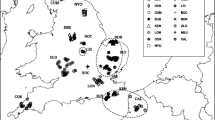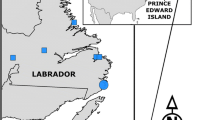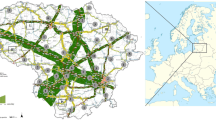Abstract
Swift fox (Vulpes velox) were historically distributed in southwestern South Dakota including the region surrounding Badlands National Park (BNP). The species declined during the mid-1800s, largely due to habitat loss and poisoning targeted at wolves (Canis lupus) and coyotes (Canis latrans). Only a small population of swift foxes near Ardmore, which is located in Fall River County, South Dakota, persisted. In 2003, a reintroduction program was initiated at BNP with swift foxes translocated from Colorado and Wyoming. Foxes released in the years 2003, 2004 and 2005 were translocated from Colorado (BNP-Colorado) whereas in 2006, released foxes were translocated from Wyoming (BNP-Wyoming). Our objective was to evaluate genetic diversity and structure of the restored swift fox population in the area surrounding BNP compared to source fox populations in an area of Colorado and Wyoming, as well as the local swift fox population neighboring BNP near Ardmore in Fall River County, South Dakota. A total of 400 swift foxes (28 released in 2003, 28 released in 2004, 26 released in 2005, 26 released in 2006, 252 wild-born foxes, 40 individual foxes from the Ardmore area of South Dakota) was genotyped using twelve microsatellite loci. We report mean gene diversity values of 0.778 (SD = 0.156) for the BNP-Colorado population, 0.753 (SD = 0.165) for the BNP-Wyoming population, 0.751 (SD = 0.171) for the BNP population, and 0.730 (SD = 0.166) for the Fall River population. We also obtained Fst values ranging from 0.014 to 0.029 for pair-wise comparisons of fox populations (BNP, Fall River, BNP-Wyoming, BNP-Colorado). We conclude that the reintroduced fox population around BNP has high genetic diversity comparable to its source populations in Colorado and Wyoming. Although genetic diversity indicates that the reintroduction was successful, additional time is necessary to fully evaluate long-term genetic maintenance and interconnectivity among these populations.

Similar content being viewed by others
References
Allardyce D, Sovada MA (2003) Review of the ecology, distribution, and status of swift foxes in the United States. In: Sovada MA, Carbyn L (eds) The swift fox: ecology and conservation of swift foxes in a changing world. Canadian Plains Research Center, Regina, pp 3–18
Allendorf FW, Luikart G (2008) Conservation and the genetics of populations. Blackwell, Malden
Allendorf FW, Ryman N (2002) The role of genetics in population viability analysis. In: Beissinger SR, McCullough DR (eds) population viability analysis. University of Chicago Press, Chicago, pp 50–85
Ausband DE, Foresman KR (2007) Dispersal, survival, and reproduction of wild-born, yearling swift foxes in a reintroduced population. Can J Zool 85:185–189
Bowcock AM, Ruizlinares A, Tomfohrde J, Minch E, Kidd JR, Cavalli-Sforza LL (1994) High resolution of human evolutionary trees with polymorphic microsatellites. Nature 368:455–457
Carbyn L (1998) COSEWIC status report on the swift fox. Committee on the status of endangered wildlife in Canada. Canadian Wildlife Service, Ottawa
Carbyn LN, Armbruster H, Mamo C (1994) The swift fox reintroduction program in Canada from 1983–1992. In: Bowels M, Whelan CJ (eds) Symposium proceedings on restoration of endangered plants and animals, University of Cambridge Press, Cambridge
Cullingham CI, Smeeton C, White BN (2007) Isolation and characterization of swift fox tetranucleotide microsatellite loci. Mol Ecol 7(1):160–162
Cullingham CI, Curteanu M, Ball MC, Manseau M (2010) Feasability and recommendations for swift fox fecal DNA profiling. J Wildl Manag 74(4):849–859
Egoscue HJ (1979) Vulpes velox. Mamm species 122:1–5
Ellegren H (1992) Polymerase-chain-reaction (PCR) analysis of micro- satellites-a new approach to studies of genetic relationships in birds. Auk 109:886–895
Fahnestock JT, Detling JK (2002) Bison-prairie dog-plant interactions in North American mixed-grass prairie. Oecologia 132:86–95
Fahrig L, Merriam G (1985) Habitat patch connectivity and population survival. Ecology 66:1762–1768
Finley DJ, White GC, Fitzgerald JP (2005) Estimation of swift fox population size and occupancy rates in Eastern Colorado. J Wildl Manag 69(3):861–873
Forbes SH, Boyd DK (1996) Genetic variation of naturally colonizing wolves in the Central Rocky Mountains. Conserv Biol 10(4):1028–1090
Francisco LV, Langston AA, Mellersh CS, Neal CL, Östrander EA (1996) A class of highly polymorphic tetranucleotide repeats for canine genetic mapping. Mamm Genome 7:359–362
Fredholm M, Wintero AK (1995) Variation of short tandem repeats within and between species belonging to the Canidae family. Mamm Genome 6:11–18
Garner A, Rachlow JL, Hicks JF (2005) Patterns of genetic diversity and its loss in mammalian population. Conserv Biol 19:1215–1221
Goudet J (2001) FSTAT, a program to estimate and test gene diversities and fixation indices (version 2.9.3). http://www.unil.ch/izea/softwares/fstat.html. Updated from Goudet (1995) FSTAT (vers. 1.2): a computer program to calculate F statistics, J Hered 86: 485–486
Harrison RL, Barr DJ, Dragoo JW (2002) A comparison of population survey techniques for swift foxes (Vulpes velox) in New Mexico. Am Midl Nat 148:320–337
Kalvels J (1982) Soil survey of Fall River County, South Dakota. Soil Conservation Service and Forest Service in cooperation with the South Dakota Agricultural Experimental Station
Kilgore DL (1969) An ecological study of the swift fox (Vulpes velox) in the Oklahoma panhandle. Am Midl Nat 81:512–534
Kitchen AM, Gese EM, Waits LP, Karki SJ, Schauster ER (2005) Genetic and spatial structure within a swift fox population. J Anim Ecol 74:1173–1181
Kitchen AM, Gese EM, Waits LP, Karki SM, Schauster ER (2006) Multiple breeding strategies in the swift fox, Vulpes velox. Anim Behav 71:1029–1038
Koons DN (2010) Genetic estimation of dispersal in metapopulation viability analysis. Anim Conserv 13:127–128
Morin PA, Moore JJ, Chakraborty R, Jin L, Goodall J, Woodruff DS (1994) Kin selection, social structure, gene flow, and the evolution of chimpanzees. Science 265:1193–1201
Nei M (1973) Analysis of gene diversity in subdivided populations. Proc Natl Acad Sci USA 70:3321–3323
Nei M (1975) Molecular population genetics and evolution. North Holland, Amsterdam
Noss RF (1987) Corridors in real landscape: a reply to Simberloff and Cox. Conserv Biol 1:159–164
Olson TL, Lindzey FG (2002) Swif fox survival and production in southeastern Wyoming. J Mammal 83(1):199–206
Östrander EA, Sprague GF, Rine J (1993) Identification and characterization of dinucleotide repeat (CA)n markers for genetic mapping in dog. Genomics 19:207–213
Ouborg NJ, Angeloni F, Vergeer P (2009) An essay on the necessity and feasibility of conservation genomics. Conserv Genet 11:643–653
Paetkau D, Strobeck C (1994) Microsatellite analysis of genetic variation in black bear populations. Mol Ecol 3:489–495
Paetkau D, Calvert W, Stirling I, Strobeck C (1995) Microsatellite analysis of population structure in Canadian polar bears. Mol Ecol 4:347–354
Ralls K, Pilgrim KL, White PJ, Paxinos EE, Schwartz MK, Fleischer RC (2001) Kinship, social relationships, and den sharing in kit foxes. J Mammal 82:858–866
Russell TA (2006) Habitat selection by swift fox in Badlands National Park and surrounding area in South Dakota. Thesis, South Dakota State University, Brookings
Saiki RK, Scharf S, Faloona F (1985) Enzymatic amplification of β-globin genomic sequences and restriction site analysis for diagnosis of sickle cell anemia. Science 230:1350–1354
Schlotterer C, Amos B, Tautz D (1991) Conservation of polymorphic simple sequence loci in cetacean species. Nature 354:63–65
Schroeder GM (2007) Effects of coyotes and release site selection on survival and movement of Translocated swift foxes in the Badlands ecosystem of South Dakota. Thesis, South Dakota State University, Brookings
Schwartz MK, Ralls K, Williams DF, Cypher BL, Pilgrim KL, Fleischer RC (2005) Gene flow among San Joaquin kit fox populations in a severely changed ecosystem. Conserv Genet 6:25–37
Segelbacher G, Hoglund J, Storch I (2003) From connectivity to isolation: genetic consequences to population fragmentation in capercaillie across Europe. Mol Ecol 12:1773–1780
Sikes RS, Gannon WL (2011) Guidelines of the American Society of Mammalogists for the use of wild mammals in research. J Mammal 92:235–253
Sovada MA, Roy CC, Bright JB, Gillis JR (1998) Causes and rates of mortality of swift foxes in western Kansas. J Wildl Manag 62:1300–1306
Swift Fox Conservation Team Annual Report (2000) In: Schmitt GC (ed) New Mexico Department of Game and Fish, Albuquerque, New Mexico
Taylor AC, Sherwin WB, Wayne RK (1994) Genetic variation of microsatellite loci in a bottlenecked species: the northern hairy-nosed wombat Lasiorbinus krefftii. Mol Ecol 3:277–290
Uresk DW, Severson KE, Javersak J (2003) Detecting swift fox: smoked-plate scent stations vs spotlighting. United States Department of Agriculture, Forest Service, Rocky Mountain Research Station, Research paper RMRS-RP-39
Weir BS, Cockerham CC (1984) Estimating F-statistics for the analysis of population structure. Evolution 38:1358–1370
Whisenant SG, Uresk DW (1989) Burning upland, mixed prairie in Badlands National Park. Prairie Nat 21:221–227
Wilkinson L (1990) SYSTAT: the system for statistics. SYSTAT Inc, Evanston
Williams CL, Blejwas K, Johnston JJ, Jaeger MM (2003) Temporal genetic variation in a coyote (Canis latrans) population experiencing high turnover. J Mammal 84:177–184
Wright S (1931) Evolution in Mendelian populations. Genetics 16:97–159
Zimmerman AL, Irby L, Giddings B (2003) The status and ecology of swift foxes in north central Montana. In: Sovada MA, Carbyn L (eds) The swift fox: ecology and conservation of swift foxes in a changing world. Canadian Plains Research Center, Regina, pp 49–59
Zumbaugh DM, Choate JR (1985) Historical biogeography of foxes in Kansas. Trans Kans Acad Sci 88:1–13
Acknowledgments
Our study was funded by the National Park Service. We appreciate the support provided by the Department of Natural Resource Management (formerly the Department of Wildlife and Fisheries Sciences) at South Dakota State University and the South Dakota Department of Game, Fish and Parks for providing administrative support for the project. Any use of trade, product, or firm names is for descriptive purposes only and does not imply endorsement by the U.S. Government. Special thanks to T. W. Grovenburg for assistance with figure creation. Also thanks to D. Schwalm for her help with PCR and K. Gedye for her help with the sequencer.
Author information
Authors and Affiliations
Corresponding author
Rights and permissions
About this article
Cite this article
Sasmal, I., Jenks, J.A., Waits, L.P. et al. Genetic diversity in a reintroduced swift fox population. Conserv Genet 14, 93–102 (2013). https://doi.org/10.1007/s10592-012-0429-8
Received:
Accepted:
Published:
Issue Date:
DOI: https://doi.org/10.1007/s10592-012-0429-8




